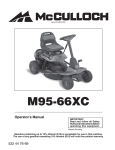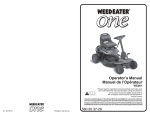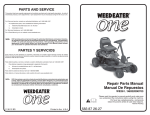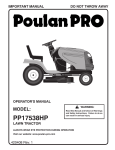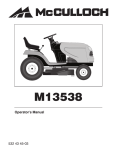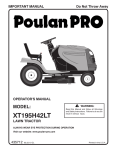Download Weed Eater One WE261 Operator`s manual
Transcript
Operator’s Manual 26" RIDING MOWER SIDE DISCHARGE ELECTRIC START Catalog No. WE261 IMPORTANT: Read and follow all Safety Rules and Instructions before operating this equipment. Patents Pending 532 43 32-03 Rev. 10 TABLE OF CONTENTS Warranty.................................................. 2 Safety Rules............................................ 3 Product Specifications............................. 6 Assembly/Pre-Operation......................... 7 Operation............................................... 10 Maintenance Schedule.......................... 16 Maintenance.......................................... 16 Service and Adjustments....................... 20 Storage.................................................. 24 Troubleshooting..................................... 25 Repair Parts........................................... 27 WARRANTY LIMITED WARRANTY The Manufacturer warrants to the original consumer purchaser that this product as manufactured is free from defects in materials and workmanship. For a period of two (2) years from date of purchase by the original consumer purchaser, we will repair or replace, at our option, without charge for parts or labor incurred in replacing parts, any part which we find to be defective due to materials or workmanship. This Warranty is subject to the following limitations and exclusions. 1. This warranty does not apply to the engine, battery (except as noted below) or components parts thereof. Please refer to the applicable manufacturer's warranty on these items. 2. Transportation charges for the movement of any power equipment unit or attachment are the responsibility of the purchaser. Transportation charges for any parts submitted for replacement under this warranty must be paid by the purchaser unless such return is requested by the manufacturer. 3. Battery Warranty: On products equipped with a Battery, we will replace, without charge to you, any battery which we find to be defective in manufacture, during the first ninety (90) days of ownership. After ninety (90) days, we will exchange the Battery, charging you 1/12 of the price of a new Battery for each full month from the date of the original sale. Battery must be maintained in accordance with the instructions furnished. 4. The Warranty does not apply to any products used for rental or commercial purposes. 5. This Warranty applies only to products which have been properly assembled, adjusted, operated, and maintained in accordance with the instructions furnished. This Warranty does not apply to any product which has been subjected to alteration, misuse, abuse, improper assembly or installation, delivery damage, or to normal wear of the product. 6. Exclusions: Excluded from this Warranty are belts, blades, blade adapters, normal wear, normal adjustments, standard hardware and normal maintenance. 7. In the event you have a claim under this Warranty, you must return the product to an authorized service dealer. Should you have any unanswered questions concerning this Warranty, please contact: In Canada contact: HOP Outdoor Products Customer Service Dept. 9335 Harris Corners Parkway Charlotte, NC 28269 USA HOP 5855 Terry Fox Way Mississauga, Ontario L5V 3E4 giving the model number, serial number and date of purchase of your product and the name and address of the authorized dealer from whom it was purchased. THIS WARRANTY DOES NOT APPLY TO INCIDENTAL OR CONSEQUENTIAL DAMAGES AND ANY IMPLIED WARRANTIES ARE LIMITED TO THE SAME TIME PERIODS STATED HEREIN FOR OUR EXPRESSED WARRANTIES. Some areas do not allow the limitation of consequential damages or limitations of how long an implied Warranty may last, so the above limitations or exclusions may not apply to you. This Warranty gives you specific legal rights, and you may have other rights which vary from locale to locale. This is a limited Warranty within the meaning of that term as defined in the Magnuson-Moss Act of 1975. 2 SAFETY RULES DANGER: This cutting machine is capable of amputating hands and feet and throwing objects. Failure to observe the following safety instructions could result in serious injury or death. • Never direct discharged material toward anyone. Avoid discharging material against a wall or obstruction. Material may ricochet back toward the operator. Stop the blade when crossing gravel surfaces. • Do not operate machine without the entire grass catcher, discharge chute, or other safety devices in place and working. • Slow down before turning. • Never leave a running machine unattended. Always turn off blade, set parking brake, stop engine, and remove keys before dismounting. • Disengage blade when not mowing. Shut off engine and wait for all parts to come to a complete stop before cleaning the machine, removing the grass catcher, or unclogging the discharge chute. • Operate machine only in daylight or good artificial light. • Do not operate the machine while under the influence of alcohol or drugs. • Watch for traffic when operating near or crossing roadways. • Use extra care when loading or unloading the machine into a trailer or truck. • Always wear eye protection when operating machine. • Data indicates that operators, age 60 years and above, are involved in a large percentage of riding mower-related injuries. These operators should evaluate their ability to operate the riding mower safely enough to protect themselves and others from serious injury. • Keep machine free of grass , leaves or other debris build-up which can touch hot exhaust / engine parts and burn. Do not allow the mower deck to plow leaves or other debris which can cause build-up to occur. Clean any oil or fuel spillage before operating or storing the machine. Allow machine to cool before storage. WARNING: In order to prevent accidental starting when setting up, transporting, adjusting or making repairs, always disconnect spark plug wire and place wire where it cannot contact spark plug. WARNING: Do not coast down a hill in neutral, you may lose control of the riding mower. WARNING: Engine exhaust, some of its constituents, and certain vehicle components contain or emit chemic als known to the State of California to cause cancer and birth defects or other reproductive harm. WARNING:This unit is not intended for towing, or use of wheel weights. Only use attachments designed specifically for this riding mower. WARNING: Battery posts, terminals and related accessories contain lead and lead compounds, chemicals known to the State of California to cause cancer and birth defects or other reproductive harm. Wash hands after handling. I. GENERAL OPERATION • Read, understand, and follow all instructions on the machine and in the manual before starting. • Do not put hands or feet near rotating parts or under the machine. Keep clear of the discharge opening at all times. • Only allow responsible adults, who are familiar with the instructions, to operate the machine. • Clear the area of objects such as rocks, toys, wire, etc., which could be picked up and thrown by the blade. • Be sure the area is clear of bystanders before operating. Stop machine if anyone enters the area. • Never carry passengers. • Do not mow in reverse unless absolutely necessary. Always look down and behind before and while backing. 3 SAFETY RULES II. SLOPE OPERATION III. CHILDREN Slopes are a major factor related to loss of control and tip-over accidents, which can result in severe injury or death. Operation on all slopes requires extra caution. If you cannot back up the slope or if you feel uneasy on it, do not mow it. • Mow up and down slopes (15° Max), not across. • Watch for holes, ruts, bumps, rocks, or other hidden objects. Uneven terrain could overturn the machine. Tall grass can hide obstacles. • Choose a low ground speed so that you will not have to stop or shift while on the slope. • Do not mow on wet grass. Tires may lose traction. • Always keep the machine in gear when going down slopes. Do not shift to neutral and coast downhill. • If machine stops while going uphill, disengage blade, shift into reverse and back down slowly. • Avoid starting, stopping, or turning on a slope. If the tires lose traction, disengage the blade and proceed slowly straight down the slope. • Keep all movement on the slopes slow and gradual. Do not make sudden changes in speed or direction, which could cause the machine to roll over. • Use extra care while operating machine with grass catchers or other attachments; they can affect the stability of the machine. • Do no use on steep slopes. • Do not try to stabilize the machine by putting your foot on the ground. • Do not mow near drop-offs, ditches, or embankments. The machine could suddenly roll over if a wheel is over the edge or if the edge caves in. Tragic accidents can occur if the operator is not alert to the presence of children. Children are often attracted to the machine and the mowing activity. Never assume that children will remain where you last saw them. • Keep children out of the mowing area and in the watchful care of a responsible adult other than the operator. • Be alert and turn machine off if a child enters the area. • Before and while backing, look behind and down for small children. • Never carry children, even with the blade shut off. They may fall off and be seriously injured or interfere with safe machine operation. Children who have been given rides in the past may suddenly appear in the mowing area for another ride and be run over or backed over by the machine. • Never allow children to operate the machine. • Use extra care when approaching blind corners, shrubs, trees, or other objects that may block your view of a child. IV. SERVICE SAFE HANDLING OF GASOLINE To avoid personal injury or property damage, use extreme care in handling gasoline. Gasoline is extremely flammable and the vapors are explosive. • Extinguish all cigarettes, cigars, pipes, and other sources of ignition. • Use only approved gasoline container. • Never remove gas cap or add fuel with the engine running. Allow engine to cool before refueling. • Never fuel the machine indoors. • Never store the machine or fuel container where there is an open flame, spark, or pilot light such as on a water heater or other appliances. 4 SAFETY RULES • Never fill containers inside a vehicle or on a truck or trailer bed with plastic liner. Always place containers on the ground away from your vehicle when filling. • Remove gas-powered equipment from the truck or trailer and refuel it on the ground. If this is not possible, then refuel such equipment with a portable container, rather than from a gasoline dispenser nozzle. • Keep the nozzle in contact with the rim of the fuel tank or container opening at all times until fueling is complete. Do not use a nozzle lock-open device. • If fuel is spilled on clothing, change clothing immediately. • Never overfill fuel tank. Replace gas cap and tighten securely. • If you strike a foreign object, stop and inspect the machine. Repair, if necessary, before restarting. • Never make any adjustments or repairs with the engine running. • Check grass catcher components and the discharge chute frequently and replace with manufacturer’s recommended parts, when necessary. • Mower blade is sharp. Wrap the blade or wear gloves, and use extra caution when servicing them. • Check brake operation frequently. Adjust and service as required. • Maintain or replace safety and instruction labels, as necessary. • Be sure the area is clear of bystanders before operating. Stop machine if anyone enters the area. • Never carry passengers. • Do not mow in reverse unless absolutely necessary. Always look down and behind before and while backing. GENERAL SERVICE • Never operate machine in a closed area. • Keep all nuts and bolts tight to be sure the equipment is in safe working condition. • Never tamper with safety devices. Check their proper operation regularly. • Keep machine free of grass, leaves, or other debris build-up. Clean oil or fuel spillage and remove any fuel-soaked debris. Allow machine to cool before storing. 5 PRODUCT SPECIFICATIONS CUSTOMER RESPONSIBILITIES Gasoline Capacity 1.2 qt. and Type: Unleaded Regular Oil Type SAE 30 (above 32°F) (API-SG-SL): SAE 5W-30(below 32°F) Oil Capacity: 20 oz. Spark Plug: Champion RC12YC (Gap: .030") Ground Speed Forward: 0-4 mph Reverse: 0-1 mph Blade Bolt Torque: 45-55 Ft. Lbs. • Read and observe the safety rules. • Follow a regular schedule in maintaining, caring for and using your riding mower. • Follow the instructions under “Maintenance” and “Storage” sections of this owner’s manual. WARNING: This riding mower is equipped with an internal combustion engine and should not be used on or near any unimproved forest-covered, brush-covered or grass-covered land unless the engine’s exhaust system is equipped with a spark arrester meeting applicable local or state laws (if any). If a spark arrester is used, it should be maintained in effective working order by the operator. In the state of California the above is required by law (Section 4442 of the California Public Resources Code). Other states may have similar laws. Federal laws apply on federal lands. A spark arrester for the muffler is available through your nearest authorized service center. UNASSEMBLED PARTS (1) Large Flat Washer Steering Wheel Insert Steering Wheel (1) 1/2-20 Jam Nut (1) Pin (1) 5/16 Flat Washer Steering Cover (1) 5/16-18 Lock Nut Steering Wheel Adapter (1) 5/16-18 x 1 1/2 Hex Bolt Steering Shaft Cover Steering Shaft (1) Washer (2) Key Seat (1) Knob 6 Slope Sheet ASSEMBLY/PRE-OPERATION Your new riding mower has been assembled at the factory with the exception of those parts left unassembled for shipping purposes. To ensure safe and proper operation of your riding mower all parts and hardware you assemble must be tightened securely. Use the correct tools as necessary to insure proper tightness. TOOLS REQUIRED FOR ASSEMBLY 4. Slide steering shaft protective foam cover over shaft. A socket wrench set will make assembly easier. Standard wrench sizes you need 5. Position front wheels of the riding mower so they are pointing straight forward. are listed below. (1) 3/4" wrench Insert Nut (1) 1/2" wrench (1) Utility knife Steering Wheel Washer (1) Tire pressure gauge When right or left hand is mentioned in this manual, it means when you are in the Adapter operating position (seated behind the steering wheel). Foam Cover TO REMOVE RIDING MOWER FROM CARTON UNPACK CARTON 1. Cut along dotted lines on all four panels of carton. Remove carton and top frame as one unit. 2. Remove packing materials from riding mower. NOTE: Only cut carton with a short blade utility knife, a long blade or saw can puncture tires on unit. Steering Shaft 6. Remove steering wheel adapter from steering wheel and slide adapter onto steering shaft. 7. Press steering wheel into position on shaft, install large washer, and tighten nut securely. 8. Snap steering wheel insert into center of steering wheel securely. INSTALL SEAT 1. Pivot seat upward and remove from the cardboard packing. Remove the cardboard packing and discard. 2. Place seat on seat pan so head of shoulder bolt is positioned over large slotted hole in pan. 3. Push down on seat to engage shoulder bolt in slot and pull seat towards rear of riding mower. HOW TO SET UP YOUR RIDING MOWER INSTALL STEERING COLUMN 1. Insert steering shaft into mount and securely fasten with bolt, washer, and nut provided. 2. Insert pin into hole in steering shaft. 3. Slide plastic cover over steering shaft and into position. Steering Shaft Plastic Cover Pin Nut Washer Steering Shaft Mount Seat Bolt Seat Pan 6 46 02 7 Shoulder Bolt 4. Pivot seat and pan forward and assemble adjustment knob and flat washer loosely. Do not tighten. WARNING: Before starting, read, understand and follow all instructions in the Operation section of this manual. Be sure riding mower is in a well-ventilated area. Be sure the area in front of riding mower is clear of other people and objects. TO ROLL RIDING MOWER OFF SKID (See Operation section for location and function of controls) Flat Washer 1. Raise deck lift lever to its highest position. 2. Release parking brake by depressing clutch/brake pedal. 3. Engage freewheel control. See “TO TRANSPORT” in the operation section of this manual. 4. Roll riding mower forward off skid. 02464 Adjustment Knob 5. Lower seat into operating position and sit in seat. 6. Slide seat until a comfortable position is reached which allows you to press clutch/ brake pedal all the way down. 7. Get off seat without moving its adjusted position. 8. Raise seat and tighten adjustment knob securely. CHECK TIRE PRESSURE The tires on your riding mower were overinflated at the factory for shipping purposes. Correct tire pressure is important for best cutting performance. • Reduce tire pressure to PSI shown on tires. CHECK BATTERY Make sure battery is securely fastened, and that all wires are securely connected. • Battery is located under the seat. • Battery has been fully charged from the factory, before installation. CHECK DECK LEVELNESS For best cutting results, mower housing should be properly leveled. See “TO LEVEL MOWER HOUSING” in the Service and Adjustments section of this manual. Seat CHECK FOR PROPER POSITON OF MOWER DRIVE BELT See the figure that is shown for replacing the mower drive belt in the service and adjustment section of this manual. Verify that the belt is routed correctly. CHECK BRAKE SYSTEM After you learn how to operate your riding mower, check to see that the brake is operating properly. See “TO ADJUST BRAKE” in the Service and Adjustments section of this manual. Battery NOTE: You may now roll your riding mower off the skid. Follow the appropriate instruction below to remove the riding mower from the skid. 8 CHECKLIST Before you operate your new riding mower, we wish to assure that you receive the best performance and satisfaction from this Quality Product. Please review the following checklist: All assembly instructions have been completed. No remaining loose parts in carton. Battery is properly connected. Seat is adjusted comfortably and tightened securely. All tires are properly inflated. (For shipping purposes, the tires were overinflated at the factory). Be sure mower deck is properly leveled side-to-side/front-to-rear for best cutting results. (Tires must be properly inflated for leveling). Check mower belt. Be sure it is routed properly around pulleys and inside all belt keepers. Check wiring. See that all connections are still secure and wires are properly clamped. Before driving riding mower, be sure freewheel control is in “transmission engaged” position (see “TO TRANSPORT” in the Operation section of this manual). While learning how to use your riding mower, pay extra attention to the following important items: Engine oil is at proper level. Fuel tank is filled with fresh, clean, regular unleaded gasoline. Become familiar with all controls, their location and function. Operate them before you start the engine. Be sure brake system is in safe operating condition. Be sure Operator Presence System and Reverse Operation System (ROS) are working properly (See the Operation and Maintenance sections in this manual). 9 OPERATION These symbols may appear on your riding mower or in literature supplied with the product. Learn and understand their meaning. REVERSE NEUTRAL HIGH LOW CHOKE FAST SLOW IGNITION SWITCH P ENGINE OFF REVERSE OPERATION SYSTEM (ROS) OVER TEMP LIGHT FUEL ENGINE ON OIL PRESSURE ENGINE START BATTERY PARKING BRAKE REVERSE FORWARD PARKING BRAKE LOCKED MOWER HEIGHT PARKING BRAKE UNLOCKED MOWER LIFT 15 ATTACHMENT CLUTCH ENGAGED ATTACHMENT CLUTCH DISENGAGED FREEWHEEL CONTROL DISENGAGED BRAKE/CLUTCH PEDAL DANGER, KEEP HANDS AND FEET AWAY 15 SLOPE HAZARDS KEEP AREA CLEAR (SEE SAFETY RULES SECTION) DANGER indicates a hazard which, if not avoided, will result in death or serious injury. WARNING indicates a hazard which, if not avoided, could result in death or serious injury. FREEWHEEL CONTROL ENGAGED Failure to follow instructions could result in serious injury or death. The safety alert symbol is used to identify safety information about hazards which can result in death, serious injury and/or property damage. CAUTION indicates a hazard which, if not avoided, might result in minor or moderate injury. CAUTION when used without the alert symbol, indicates a situation that could result in damage to the tractor and/or engine. HOT SURFACES indicates a hazard which, if not avoided, could result in death, serious injury and/or property damage. FIRE indicates a hazard which, if not avoided, could result in death, serious injury and/or property damage. 10 KNOW YOUR RIDING MOWER READ THIS OWNER'S MANUAL AND SAFETY RULES BEFORE OPERATING YOUR RIDING MOWER Compare the illustrations with your riding mower to familiarize yourself with the locations of various controls and adjustments. Save this manual for future reference. Parking Brake Pedal Brake Pedal ROS "ON" Deck Clutch Lever Ignition Switch Lift Lever Plunger Motion Control Lever Height Adjustment Lever Freewheel Control Our riding mowers conform to the applicable safety standards of the American National Standards Institute. PARKING BRAKE LEVER - Locks parking brake into brake position. MOTION CONTROL LEVER - Selects the speed and direction of the riding mower. FREEWHEEL CONTROL - Disengages transmission for pushing or slowly towing the riding mower with the engine off. ROS “ON” POSITION - Allows operation of mower deck or other powered attachment while in reverse. DECK CLUTCH LEVER - Used to engage the mower blade. BRAKE PEDAL - Used for braking the riding mower and starting the engine. HEIGHT ADJUSTMENT LEVER - Used to adjust mower cutting height. IGNITION SWITCH - Used for starting and stopping the engine. LIFT LEVER PLUNGER - Used to release height adjustment lever when changing its position. 11 00155 The operation of any riding mower can result in foreign objects thrown into the eyes, which can result in severe eye damage. Always wear safety glasses or eye shields while operating your riding mower or performing any adjustments or repairs. We recommend a wide vision safety mask over spectacles or standard safety glasses. HOW TO USE YOUR RIDING MOWER NOTE: Under certain conditions when riding mower is standing idle with the engine running, hot engine exhaust gases may cause “browning” of grass. To eliminate this possibility, always stop engine when stopping riding mower on grass areas. TO SET PARKING BRAKE Your riding mower is equipped with an operator presence sensing switch. When engine is running, any attempt by the operator to leave the seat without first setting the parking brake will shut off the engine. 1. Depress brake pedal all the way down and hold. 2. Depress parking brake lever and release pressure from brake pedal. Pedal should remain in brake position. Make sure parking brake will hold riding mower secure. Pa r k i n g B r a k e Pedal-Push Down to "Engage" Motion Control Lever CAUTION: Always stop riding mower completely, as described above, before leaving the operator's position. TO MOVE FORWARD AND BACKWARD The direction and speed of movement is controlled by the motion control lever. 1. Start riding mower with clutch/brake pedal depressed and motion control lever in neutral (N) position. 2. Move motion control lever to desired position. 3. Slowly release clutch/brake pedal to start movement. IMPORTANT: Bring riding mower to a complete stop before shifting or changing gears. Failure to do so will shorten the useful life of your transaxle. Mower Height Adjustment Deck Clutch Lever Brake Pedal "Disengaged" "Engaged" Position Deck Clutch Position Brake Pedal Lever "Drive" "Engaged" Position Position STOPPING MOWER BLADE • To stop mower blade, move deck clutch lever to disengaged position. GROUND DRIVE • To stop ground drive, depress brake pedal all the way down. ENGINE • Turn ignition key to “STOP” position and remove key. Always remove key when leaving riding mower to prevent unauthorized use. IMPORTANT: Leaving the ignition switch in any position other than "STOP" will cause the battery to discharge and go dead. 12 TO ADJUST MOWER CUTTING HEIGHT The position of the mower height deck lift lever determines the cutting height. • Grasp lift lever. • Press lift lever plunger with thumb and move lever to desired position. The cutting height range is approximately 1-1/2 to 4". The heights are measured from the ground to the blade tip with the engine not running. These heights are approximate and may vary depending upon soil conditions, height of grass and types of grass being mowed. • The average lawn should be cut to approximately 2-1/2" during the cool season and to over 3" during hot months. For healthier and better looking lawns, mow often and after moderate growth. • For best cutting performance, grass over 6" in height should be mowed twice. Make the first cut relatively high; the second to desired height. TO OPERATE MOWER Your riding mower is equipped with an operator presence sensing switch. Any attempt by the operator to leave the seat with the engine running and the deck clutch engaged will shut off the engine. You must remain fully and centrally positioned in the seat to prevent the engine from hesitating or cutting off when operating your equipment on rough, rolling terrain or hills. 1. Select desired height of cut. 2. Start mower blade by engaging deck clutch lever. TO STOP MOWER BLADEDisengage deck clutch lever. Deck Clutch Lever "Disengaged" Position Deck Clutch Lever "Engaged" Position REVERSE OPERATION SYSTEM (ROS) Your tractor is equipped with a Reverse Operation System (ROS). Any attempt by the operator to travel in the reverse direction with the deck clutch engaged will shut off the engine unless ignition key is placed in the ROS "ON" position. WARNING: Backing up with the deck clutch engaged while mowing is strongly discouraged. Turning the ROS "ON", to allow reverse operation with the deck clutch engaged, should only be done when the operator decides it is necessary to reposition the machine with the attachment engaged. Do not mow in reverse unless absolutely necessary. Mower Height Adjustment High Position USING THE REVERSE OPERATION SYSTEM Only use if you are certain no children or other bystanders will enter the mowing area. 1. Move motion control lever to neutral (N) position. 2. With engine running, turn ignition key counterclockwise to ROS "ON" position. 3. Look down and behind before and while backing. 4. Slowly move motion control lever to reverse (R) position to start movement. 5. When use of the ROS is no longer needed, turn the ignition key clockwise to engine "ON" position. Mower Height Adjustment Low Position ROS "ON" Position Engine "ON" Position (Normal Operating) CAUTION: Do not operate the mower without either the entire grass catcher, on mowers so equipped, or the deflector shield in place. 02828 Deflector Shield 13 • For cold weather operation you should change oil for easier starting (See the oil viscosity chart in the Maintenance section of this manual). • To change engine oil, see the Maintenance section in this manual. ADD GASOLINE • Fill fuel tank to bottom of filler neck. Do not overfill. Use fresh, clean, regular unleaded gasoline with a minimum of 87 octane. (Use of leaded gasoline will increase carbon and lead oxide deposits and reduce valve life). Do not mix oil with gasoline. Purchase fuel in quantities that can be used within 30 days to assure fuel freshness. CAUTION: Wipe off any spilled oil or fuel. Do not store, spill or use gasoline near an open flame. TO OPERATE ON HILLS WARNING: Do not drive up or down hills with slopes greater than 15° and do not drive across any slope. Use the slope guide at the back of this manual. • Choose the slowest speed before starting up or down hills. • Avoid stopping or changing speed on hills. • If stopping is absolutely necessary, push clutch/brake pedal quickly to brake position and engage parking brake. • Move motion control lever to neutral (N) position. • To restart movement, slowly release parking brake and clutch/brake pedal. • Make all turns slowly. TO TRANSPORT When pushing or towing your riding mower, be sure to disengage transmission by placing freewheel control in freewheel position. Freewheel control is located at the rear drawbar of the riding mower. • Raise mower height adjustment to its highest position with mower height adjustment lever. • Push freewheel control down and over with foot. CAUTION: Alcohol blended fuels (called gasohol or using ethanol or methanol) can attract moisture which leads to separation and formation of acids during storage. Acidic gas can damage the fuel system of an engine while in storage. To avoid engine problems, the fuel system should be emptied before storage of 30 days or longer. Drain the gas tank, start the engine and let it run until the fuel lines and carburetor are empty. Use fresh fuel next season. See Storage Instructions for additional information. Never use engine or carburetor cleaner products in the fuel tank or permanent damage may occur. Freewheel Control Disengaged TO START ENGINE When starting the engine for the first time or if the engine has run out of fuel, it will take extra cranking time to move fuel from the tank to the engine. 1. Be sure freewheel control is in the transmission engaged position. 2. Sit on seat in operating position, depress clutch/brake pedal and set parking brake. 3. Place motion control lever in neutral (N) position. 4. Move deck clutch to disengaged position. 5. Insert key into ignition and turn key clockwise to start position and release key as soon as engine starts. Do not run starter continuously for more than fifteen seconds per minute. NOTE: If at high altitude (above 3000 feet) or in cold temperature (below 32°F) the fuel mixture may need to be adjusted for best performance. Freewheel Control Engaged • To reengage transmission, reverse above procedure, or press brake lever all the way down. BEFORE STARTING THE ENGINE CHECK ENGINE OIL LEVEL The engine in your riding mower has been shipped, from the factory, already filled with summer weight oil. 1. Check engine oil with riding mower on level ground. 2. Remove oil fill cap/dipstick and wipe clean, reinsert the dipstick and screw cap tight, wait for a few seconds, remove and read oil level. If necessary, add oil until “FULL” mark on dipstick is reached. Do not overfill. 14 RECOIL STARTING SYSTEM This unit is equipped with an engine recoil starting system. If the battery is too weak to start engine. 1. Set parking Brake. 2. Turn key to ON position. 3. Make sure unit is in neutral position. 4. Set deck to disengaged position. 5. Pull recoil cord to start engine. • Do not mow grass when it is wet. Wet grass will plug mower and leave undesirable clumps. Allow grass to dry before mowing. • Regulate ground speed by selecting a low enough gear to give the mower cutting performance as well as the quality of cut desired. • When operating attachments, select a ground speed that will suit the terrain and give best performance of the attachment being used. Gasoline Filler Cap Recoil Starter Handle MOWING TIPS • Mower should be properly leveled for best mowing performance. See “TO LEVEL MOWER HOUSING” in the Service and Adjustments section of this manual. • The left hand side of mower should be used for trimming. • Drive so that clippings are discharged onto the area that has already been cut. Have the cut area to the right of the riding mower. This will result in a more even distribution of clippings and more uniform cutting. • When mowing large areas, start by turning to the right so that clippings will discharge away from shrubs, fences, driveways, etc. After one or two rounds, mow in the opposite direction making left hand turns until finished. • If grass is extremely tall, it should be mowed twice to reduce load and possible fire hazard from dried clippings. Make first cut relatively high;









































